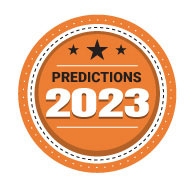
5 trends experts expect in the Web 3 industry in 2023


 Even as the prices of some cryptocurrencies have dropped to all-time-lows, the downturn in the market hasn’t really affected the rollout of Web 3.0 use-cases around the world. For instance, Indian telco Airtel acquired blockchain firm Aquilliz in February 2022, aiming to use the company’s technology for in-house advertising efforts. Similarly, payments firms like MasterCard and Visa have added crypto support to their networks, while central banks have been ramping up the development of central bank digital currencies (CBDCs).
Even as the prices of some cryptocurrencies have dropped to all-time-lows, the downturn in the market hasn’t really affected the rollout of Web 3.0 use-cases around the world. For instance, Indian telco Airtel acquired blockchain firm Aquilliz in February 2022, aiming to use the company’s technology for in-house advertising efforts. Similarly, payments firms like MasterCard and Visa have added crypto support to their networks, while central banks have been ramping up the development of central bank digital currencies (CBDCs).
The fall of crypto exchange FTX may have hurt sentiments worldwide, but even as crypto experiences all-time-lows, the use of blockchain and Web 3.0 technologies is only expected to grow in 2023. Here are some trends that experts expect from the industry next year.
Risk in the crypto sector remains

The year 2022 was turbulent for cryptocurrency. A crypto winter has eclipsed the world for the better part of the year. The collapse of one of the biggest crypto exchanges FTX in December this year further exacerbated the situation. The chances of a bounce back in 2023 looks uncertain.
As the CEO of crypto tax software CoinLedger, David Kemmerer, said in an interview with Forbes, this winter is here to stay for some time. He attributed that to macroeconomic factors, including “40-year highs in inflation, rising borrowing costs and political instability after Russia invaded Ukraine.” Others like Dileep Seinberg, founder and CEO of MuffinPay, also believe that 2023 is probably going to be a year of growth and consolidation and emergence of new projects and potential signs of improving sentiment in the later part of the year. Some also expect to see more real-world use cases driving the industry forward.
Utility NFTs to evolve

Until now, the vast majority of non-fungible tokens (NFTs) have been just digital pieces of art with tremendous prices, often lacking a practical usage. This concern is giving rise to utility NFTs, enhancing the concept of digital collectibles by providing holders with real-world rewards and other privileges linked to ownership. For example, these can be used for a variety of practical applications, like a ticket to an event or providing a holder with long-term membership to a club.
Some NFT projects, like Bored Ape Yacht Club (BAYC) and Doodles have begun adding utility for holders, like exclusive access to premium parties or meetups. Other NFT projects, like Coachella Collectibles, offer lifetime pass to the music festival, alongside benefits like unique on-site experiences and physical goods. In 2023, more NFT efforts like this are expected to emerge.
More sustainability efforts in Web 3.0

The Web 3.0 industry has very high energy usage, most of which comes from fossil fuels – a cause of concern for the industry in general. According to the Cambridge University's Bitcoin Energy Consumption Index, a real-time tracker of energy consumed by Bitcoin mining, that Bitcoin alone uses 83.68 terra-watt hours of electricity per year — more than, some of the countries in the world.
Perhaps the most notable green effort was the Ethereum Merge in September 2022, where the blockchain switched from proof-of-work (PoW) to proof-of-stake (PoS), which over time is expected to lead to a 98% reduction in the overall amount of energy used by the network.
Recently, the World Economic Forum launched the Crypto Sustainability Coalition to focus on accelerating the adoption of ReFi (regenerative finance space) use cases, which seeks to promote financial incentives for projects and is an effective way to preserve planetary wellbeing.

Metaverse investments to grow
Metaverse, which is linked to web 3.0, is a 3D interactive experience space that allows users to interact with 3D objects using augmented, virtual, and mixed reality. According to a June 15, 2022 report by consulting firm, McKinsey & Company, two thirds of consumers are excited to transition everyday activities to the metaverse in the next 12 months and that more than $120 billion has been invested in building metaverse infrastructure and technology in the first five months of 2022.
That is more than twice the $57 billion that was invested in 2021 as a whole. Despite Meta’s struggle with its metaverse this year, investors and brands are set to bridge the gap between the virtual and the actual world, numerous end-user players such as Adidas, Gucci, Nike, Meta, Starbucks, among others, are entering the metaverse in myriad ways to experiment with new online experiences and the entire Web 3.0 community is betting big on this immersive technology for the next one year.

CBDC rollouts to increase
Since 2021, world governments have been working on central bank digital currencies (CBDC) efforts. According to American think tank Atlantic Council’s December 2022 tracker CBDCs are in the research and development phase for over 100 countries. Eleven countries have launched their CBDC programs, including Jamaica, Nigeria and the Bahamas, while countries like China, India and Thailand are in the pilot phase.
On December 1, the Reserve Bank of India (RBI) announced the launch of India’s CBDC, which covers the four cities of Mumbai, New Delhi, Bengaluru, and Bhubaneswar right now. It has onboarded four banks, namely, State Bank of India, ICICI Bank, Yes Bank, and IDFC First Bank.

More such CBDCs may roll out across the world next year.
